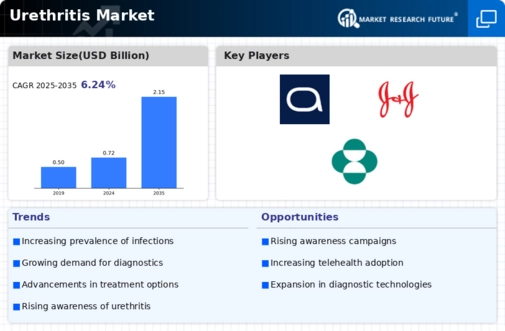Market Analysis
In-depth Analysis of Urethritis Market Industry Landscape
Due to more instances, improved diagnosis, and innovative treatments, the urethritis market is evolving swiftly. Those who wish to fulfill the growing demand for renal health products must adapt to market trends. The market for urethritis is changing as more individuals acquire it and more physicians and people learn about it. As more individuals learn about urethritis, demand for diagnostic tools, therapies, and prevention methods rises. New screening methods including genetic and point-of-care assays are transforming the urethritis industry. These innovative methods speed up and improve issue diagnosis, allowing therapy to be targeted and begun on time. The shifting diagnostics environment affects healthcare and patient outcomes. The number of antibiotic-resistant urethritis bacteria affects the market. Because germs are becoming antibiotic-resistant, new antimicrobials and other treatments are needed. Pharmaceutical firms addressing this issue boost urethritis market competition. The way the market works is affected by attempts to teach people about sexual health and take preventative steps. The number of cases of urethritis is affected by programs that promote safe sexual practices, the use of barrier methods, and regular tests. The market is shaped in part by companies that run teaching programs and offer preventative health care. The market for urethritis is moving in line with a larger trend toward care that is focused on the patient. Personalized treatment plans that take into account what the patient wants and has experienced affect how the market works. Companies that focus on educating and supporting patients are part of a complete method to treating urethritis. Regional differences in the urethritis market are caused by changes in how healthcare is provided around the world. Market growth tactics and attempts to localize products are affected by things like how people in different cultures feel about sexual health, the availability of healthcare, and the rules for diagnosing problems. Ongoing research and development projects have a big impact on how the market works. By spending in new therapies like vaccines or antimicrobials, companies are adding to the number of choices for treating and avoiding urethritis, which has an effect on market growth. The urethritis market is affected by economic factors such as healthcare costs and payment policies. The cost of medical tests and medicines can affect how many patients can get them and how healthcare providers make decisions, which can change market trends and competition. The rules that control urinary health and viral diseases have a big impact on how the urethritis market works. Tough rules about drug approvals, testing tools, and treatment plans affect how companies plan to grow their products and how they enter new markets. The urethritis market is changing because telehealth and digital health options are being used together. Telehealth systems, digital tools for self-monitoring, and remote talks all help make healthcare services easier to get and get patients more involved. Companies that use these tools will help shape how urethritis is treated in the future.

















Leave a Comment